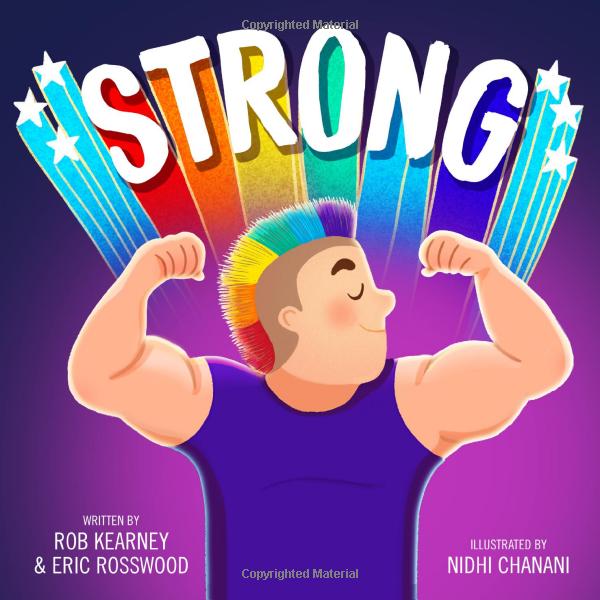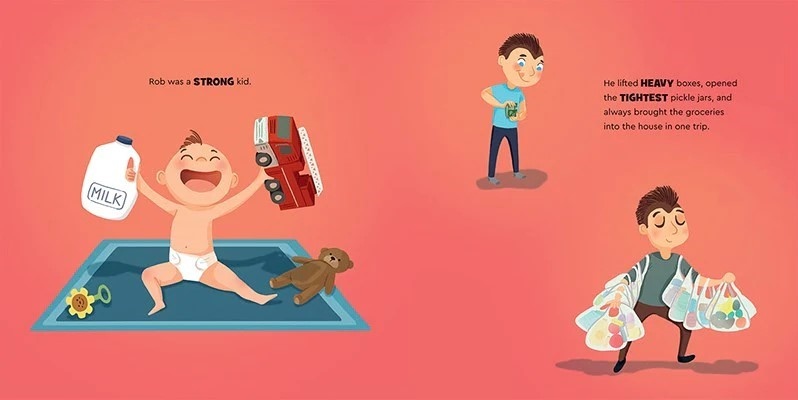
Inclusive Children's Book Teaching Guide
Strong
What is this book about?
Rob dreams of becoming a champion strongman. He wants to flip huge tires, lug boulders, haul trucks, and be the strongest man in the world! But he feels like he can’t fit in with his bright leggings, unicorn T-shirts and rainbow-dyed hair. Will Rob find a way to step into his true self and be a champion?
With bold illustrations and engaging, informative text, Strong tells the story of Rob Kearney's inspiring journey from a kid trying to find his place in society to international acclaim as the world's first openly gay professional strongman. This Stonewall Honor Book teaches children that there are a lot of different ways to be STRONG!
Who is depicted in this book?
- LGBTQ+ adults
- People who transcend gender stereotypes
What early childhood themes and concepts does this book explore?
- Colors and the emotions they evoke in us
- A variety of descriptive words/synonyms (e.g., mighty, sturdy, powerful)
- The concept of being who you really are
- How the people who love us make us feel safe and strong
How does this book support anti-bias education?
With its focus on self-acceptance and love—regardless of our interests, choices or the people we love—this story can be used to support young children as they explore the concept of identity. The story shows that there is more than one way to be strong, and that "being yourself no matter what" takes strength and confidence. These concepts help children develop a sense of pride in their identities.
Depending on how the book is shared or used—and the developmental level of the children—Strong may be used to support the following core goal from Anti-Bias Education for Young Children and Ourselves:
Identity—Teachers will nurture each child’s construction of knowledgeable and confident personal and social identities so that children will demonstrate self-awareness, confidence, family pride, and positive social identities.
How can this book be used to meet early childhood learning standards?
For all ages
Use Strong to meet early childhood literacy standards
For children from birth to age three
Teaching suggestion:
- Model or act out:
- Concepts such as big, strong and heavy
- Actions such as push and pull
- Directional concepts such as up and down
- The concept of “more” as the author presents these ideas together
What Illinois Early Learning Guideline does this meet for children from birth to age three?
Developmental DomainCognitive Development
Standard: Concept DevelopmentChildren demonstrate the ability to connect pieces of information in understanding objects, ideas and relationships.
Indicators for children:
- Understands the concept of more with regard to food and play (7–18 months)
- Begins to use descriptive words for people in a more complex fashion, such as “He big” or “She baby” (16–24 months)
- Uses descriptive words when communicating about others, such as “She ran fast” or “He is short” (21–36 months)
Teaching suggestion: Point out, name and describe the many objects that Rob lifts throughout the book. You can even imitate his actions with objects from the classroom.
What Illinois Early Learning Guideline does this meet for children from birth to age three?
Developmental DomainCognitive Development
Standard: Concept DevelopmentChildren demonstrate the ability to connect pieces of information in understanding objects, ideas and relationships.
Indicators for children:
- Begins to identify and name objects and people (16–24 months)
- Begins to identify characteristics of the object, such as “red ball” (16–24 months)
- Identifies characteristics of objects and people when named, such as colors (21–36 months)
Teaching suggestion: Point out the different clothing items that Rob wears, including their names, features, purpose, and details such as pictures and patterns. You might also introduce the concept of change as Rob’s size, hairstyle and hair color change from page to page.
What Illinois Early Learning Guideline does this meet for children from birth to age three?
Developmental DomainCognitive Development
Standard: Science Concepts and ExplorationChildren demonstrate a basic awareness of and use scientific concepts.
Indicators for children:
- Begins simple categorizing (16–24 months)
- Identifies various attributes of objects, food and materials such as color, shape and size (21–36 months)
- Draws on past experience to describe and communicate about observations and experiences such as “how things change” (21–36 months)
Teaching suggestion: Point out the many activities that Rob and Joey share—such as exercising, cheering each other on, and holding hands—to show how people support and love one another.
What Illinois Early Learning Guideline does this meet for children from birth to age three?
Developmental DomainLanguage Development, Communication and Literacy
Standard: Early LiteracyChildren demonstrate interest in and comprehension of printed materials.
Indicators for children:
- Points to familiar pictures and actions in books (16–24 months)
- Recites part of book from memory (21–36 months)
For preschoolers (ages three to five)
Teaching suggestion: Use this book share as an opportunity to challenge young children’s assumptions about gender expression and stereotypes.
What Illinois Early Learning and Development Standards does this meet for preschoolers?
Social/Emotional Development Standard31ADevelop positive relationships with peers and adults.
Benchmark 31.A.ECb:
Recognize the feelings and perspectives of others.
Benchmark 31.A.ECe:
Develop positive relationships with peers.
Teaching suggestion: Invite the children to think about how Rob felt when people looked at him strangely and made comments about his clothing and hairstyle. Ask: "How does it feel to be teased? What could we do to stop this or help others who have been hurt?"
What Illinois Early Learning and Development Standards does this meet for preschoolers?
Social/Emotional Development Standard32BApply decision‐making skills to deal responsibly with daily academic and social situations.
Benchmark 32.B.ECa:
Participate in discussions about finding alternative solutions to problems.
Teaching suggestion: Invite the children to share and discuss their own strengths. With assistance, the children can share a moment when they felt very strong or someone made them feel strong.
What Illinois Early Learning and Development Standards does this meet for preschoolers?
Language Arts Standard5BUse writing to represent ideas and information.
Benchmark 5.B.ECc:
With teacher assistance, use a combination of drawing, dictating, or writing to narrate a single event and provide a reaction to what happened.
Teaching Suggestion: During a book share, point out the descriptive adjectives used to describe the main character at different points in the story. Many of these are synonyms (e.g., sturdy, powerful, strong). Ask the children to describe other people or experiences with a range of descriptive adjectives.
What Illinois Early Learning and Development Standards does this meet for preschoolers?
Language Arts Standard1EUse increasingly complex phrases, sentences and vocabulary.
Benchmark 1.E.ECe:
With teacher assistance, use adjectives to describe people, places, and things.
Teaching suggestion: Compare the real-life Rob in the photos at the end of the book to the Rob in the story illustrations. How are they similar and different in terms of clothing, appearance, hairstyle, and the items that Rob is lifting?
What Illinois Early Learning and Development Standards does this meet for preschoolers?
Language Arts Standard2DEstablish personal connections with books.
Benchmark 2.D.ECa:
With teacher assistance, discuss illustrations in books and make personal connections to the pictures and story.
See inside this book.

What other resources are available?
Check out the many Strong author interviews, podcasts and read-aloud videos posted online.
